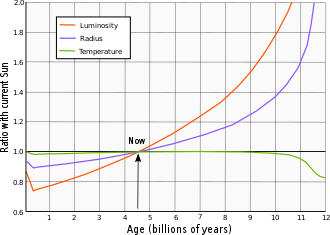
The solar luminosity (L☉) is a unit of radiant flux (power emitted in the form of photons) conventionally used by astronomers to measure the luminosity of stars, galaxies and other celestial objects in terms of the output of the Sun.
One nominal solar luminosity is defined by the International Astronomical Union to be 3.828×10 W. The Sun is a weakly variable star, and its actual luminosity therefore fluctuates. The major fluctuation is the eleven-year solar cycle (sunspot cycle) that causes a quasi-periodic variation of about ±0.1%. Other variations over the last 200–300 years are thought to be much smaller than this.
Determination
Solar luminosity is related to solar irradiance (the solar constant). Solar irradiance is responsible for the orbital forcing that causes the Milankovitch cycles, which determine Earthly glacial cycles. The mean irradiance at the top of the Earth's atmosphere is sometimes known as the solar constant, I☉. Irradiance is defined as power per unit area, so the solar luminosity (total power emitted by the Sun) is the irradiance received at the Earth (solar constant) multiplied by the area of the sphere whose radius is the mean distance between the Earth and the Sun: where A is the unit distance (the value of the astronomical unit in metres) and k is a constant (whose value is very close to one) that reflects the fact that the mean distance from the Earth to the Sun is not exactly one astronomical unit.
See also
References
- Ribas, Ignasi (February 2010), "The Sun and stars as the primary energy input in planetary atmospheres" (PDF), Solar and Stellar Variability: Impact on Earth and Planets, Proceedings of the International Astronomical Union, IAU Symposium, vol. 264, pp. 3–18, arXiv:0911.4872, Bibcode:2010IAUS..264....3R, doi:10.1017/S1743921309992298, S2CID 119107400
- "Resolution B3 on recommended nominal conversion constants for selected solar and planetary properties" (PDF). International Astronomical Union. 2015. Retrieved 5 June 2018.
- Vieira, L. E. A.; Norton, A.; Dudok De Wit, T.; Kretzschmar, M.; Schmidt, G. A.; Cheung, M. C. M. (2012). "How the inclination of Earth's orbit affects incoming solar irradiance" (PDF). Geophysical Research Letters. 39 (16): L16104 (8 pp.). Bibcode:2012GeoRL..3916104V. doi:10.1029/2012GL052950. insu-01179873.
- Noerdlinger, Peter D. (2008). "Solar Mass Loss, the Astronomical Unit, and the Scale of the Solar System". Celestial Mechanics and Dynamical Astronomy. 801: 3807. arXiv:0801.3807. Bibcode:2008arXiv0801.3807N.
Further reading
- Sackmann, I.-J.; Boothroyd, A. I. (2003), "Our Sun. V. A Bright Young Sun Consistent with Helioseismology and Warm Temperatures on Ancient Earth and Mars", Astrophys. J., 583 (2): 1024–39, arXiv:astro-ph/0210128, Bibcode:2003ApJ...583.1024S, doi:10.1086/345408, S2CID 118904050
- Foukal, P.; Fröhlich, C.; Spruit, H.; Wigley, T. M. L. (2006), "Variations in solar luminosity and their effect on the Earth's climate", Nature, 443 (7108): 161–66, Bibcode:2006Natur.443..161F, doi:10.1038/nature05072, PMID 16971941, S2CID 205211006
- Pelletier, Jon D. (1996), "Variations in Solar Luminosity from Timescales of Minutes to Months", Astrophys. J., 463 (1): L41 – L45, arXiv:astro-ph/9510026, Bibcode:1996ApJ...463L..41P, doi:10.1086/310049, S2CID 7372755
- Stoykova, D. A.; Shopov, Y. Y.; Ford, D.; Georgiev, L. N.; et al. (1999), "Powerful Millennial-Scale Solar Luminosity Cycles and Their Influence Over Past Climates and Geomagnetic Field", Proceedings of the AGU Chapman Conference: Mechanisms of Millennial Scale Global Climate Change
External links
- LISIRD: LASP Interactive Solar Irradiance Datacenter
- Stellar Luminosity Calculator
- Solar Luminosity
- Variation of Solar Luminosity
 where A is the
where A is the